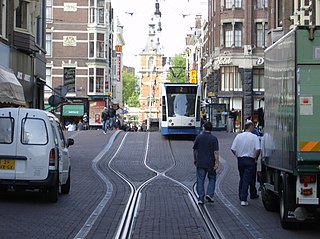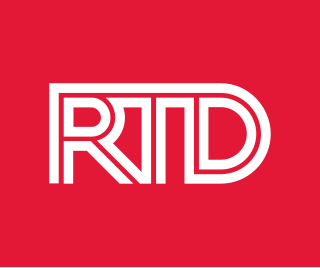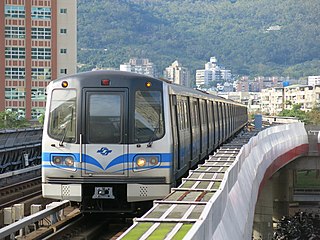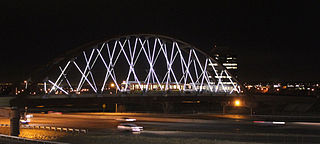This article has multiple issues. Please help improve it or discuss these issues on the talk page . (Learn how and when to remove these template messages)
|
Below are the known health impacts of light rail systems.
This article has multiple issues. Please help improve it or discuss these issues on the talk page . (Learn how and when to remove these template messages)
|
Below are the known health impacts of light rail systems.
Research shows that using light rail increases walking. Frank et al. (2004) [1] report that obesity around Atlanta, as measured by body mass index (BMI), is associated positively with time spent in cars and negatively with mixed land-use (such as incorporating Light Rail transit) and with walking. There is also research which suggests that utilizing Light Rail transit increases physical activity even compared to riding the bus. Users of public transit who do not use trains or light rail walk an additional six minutes compared with non-users, whereas those who use trains or light rail walk an additional 4.5 minutes, for a total of 10.5 extra minutes per day. [2] Additionally, MacDonald, et al. (2010) [3] used data collected pre and post light rail development in Charlotte, North Carolina to determine that residents who commuted via light rail had 81% reduced odds of becoming obese.
Moreover, bicycle access to light rail transit can increase physical activity, as people will generally bicycle three to five miles to transit, as opposed the one‐half mile distance the average person is willing to walk. Research also shows that less time spent driving results in a reduced stress level, resulting in a higher quality of life.
Though there are significant potential public health benefits due to light rail, some studies have indicated the discrepancy between the enormous costs of building and operating light rail and its significant, but certainly smaller potential benefit to public health costs (estimated at $12.6 million savings over 9 years). [4]
As such costs and benefits are being weighed it is also essential to recognize the potentially negative health impacts, including injury hazards that accompany light rail. It is equally if not more important that such hazards be closely monitored and mitigated to ensure public health and safety.
One electric light rail train produces nearly 99 percent less carbon monoxide and hydrocarbon emissions per mile than one automobile does. A report from the American Public Transit Association (APTA) presents evidence that each person riding light rail transit versus driving an automobile for one year reduces hydrocarbon emission by nine pounds, nitrogen oxide emissions by five pounds and carbon monoxide emissions by 62.5 pounds. [5] Furthermore, bicycle access on light rail and bicycle lockers at park and rides remain a priority for RTD, which further contributes to cleaner air. A large proportion of air pollution is generated in the first few miles of an auto trip when the engine is cold. From an air quality standpoint, biking to stations at the start or end of a workday trip eliminates "cold‐start" vehicle emissions associated with driving to a park and ride.
Some negative consequences are increases in noise level, loss of wetlands, adverse impacts to historic sites, gentrification, and risk of displacement. [6] A 2011 study done by Human Impact Partners in Minnesota showed that light rail and RTD expansion in their communities had at least one if not all of these negative outcomes: higher rate of residential and business displacement, increase in housing values causing fewer vacancies and a decrease in affordable housing, and displacement of existing residents—especially low income residents. [7] The study showed that there was a disproportionate impact on minorities and people with lower socio-economic status compared to European people and people with high socio-economic status. Moreover, the risk of displacement can also lead to negative health outcomes such as infectious disease, chronic disease, stress, and impeded child development due to lack of sense of belonging and association to a particular community.
Automobile injury hazards arise due to existing light rails. Coifman et al. (1997) [8] concluded that drivers engage in undesirable behaviors or actions, which are not considered hazardous, are rather legal to do. Driver's actions such as disobedience to traffic rules and signs, as well as failure to perceive due to poor stimulus observability are factors of hazard causation. Such factors include the misinterpretation of a light rail vehicle horn as another automobile's horn, and the driver's expectation of a normal intersection when in actuality the intersection includes a light rail crossing.
Pedestrians are also at risk of being injured by light rail vehicles, either by crossing rail tracks or ignoring traffic signs, especially where there is limited walkability to safely access the rail stop area. Currently, there is minimal literature available for pedestrian and automobile safety measures and traffic safety concerns (Brown et al., 2011). [9] Further investigation and data collection is needed to prevent these injury hazards.
Chronic diseases are highly prevalent among individuals who do not have convenient food access. Many residents of food deserts rely on convenience stores, liquor stores, gas stations and drug stores to provide food items (Colorado Health Foundation, 2009). [10] Light rail could contribute to lower rates of obesity and other nutrition-related chronic diseases, such as hypertension and diabetes, by increasing the likelihood that residents in food deserts can easily travel to neighborhoods with cheaper and healthier food options. Research also indicates improved access contributes to improved health outcomes. Similarly, having convenient and affordable light rail access could enable residents with little access to healthcare facilities the opportunity to travel to other neighborhoods with more healthcare providers.
According to the Centers for Disease Control, individuals from low socioeconomic status are more likely than average to use transit as their principle mode for commuting. However, they are often displaced disproportionately with light rail expansion. The most effective predictors of health, according to the National Institutes of Health, are income, poverty, population density, access to public transportation, access to affordable housing, environmental pollution (air and water). While public transportation is a necessary component of improving health of individuals of low socioeconomic status, policies must be changed to make the benefits equal with the challenges.
According to RTD (2012), [11] when new development occurs near stations, it increases the likelihood that residents and workers will choose transit as their transportation mode. This reduces the growth in vehicle miles traveled (VMT) and auto trips on a constrained roadway system while, at the same time, accommodating new growth.
Furthermore, according to The Housing + Transportation Affordability Index (2012), [12] housing near transit provides residents with an opportunity to decrease their combined household and transportation costs. Residents in locations with close proximity to transit, shorter distances to major employment, and lower vehicle ownership have lower monthly transportation costs.
The effect of displacement on communities, especially low socioeconomic communities, cannot be underestimated. Public transportation is an important resource for low socioeconomic communities. However, with light rail developments, there is national precedent for the displacement and tremendous negative impacts upon low socioeconomic communities. Both residential and business displacement can have significant negative impacts on health of already vulnerable communities. As housing values rise and fewer vacancies exist, the displacement of existing residents, especially low income residents, begins to happen. This places a disproportionate impact on minorities compared with Europeans. This displacement can have multiple negative impacts, including negative health outcomes including infectious disease, chronic disease, stress and impeded child development.
RTD would be wise to look to Minnesota to find how their Transit Oriented Development addressed the economic and public health needs of the communities affected by the placement of light rail. [7] For example, using restorative investment to ensure that low socioeconomic communities are not unduly burdened and pushed aside as light rail tends to gentrify neighborhoods beyond the reach of the poor; opening access to opportunity by rethinking zoning policies, de-concentrating subsidized housing, re-thinking school boundaries; and growing a community together to ensure there are healthy environments for all –not just those who are passing through on light rail or moving to newly renovated areas. [13]
The CDC, [14] WHO [15] and American Public Health Association [16] all advocate that "Health Impact Assessments can help ensure health is considered when shaping future transportation policy". Yet despite these recommendations and a growing body of research on Health Impact Assessment Best Practices, [17] [18] [19] [20] [21] [22] [23] FasTracks has not conducted health impact assessments for the vast majority of its proposed stops. From a public health perspective, having independent, 3rd party health impact assessments conducted would be a wise investment for the long-term economic and public health considerations of the affected communities and would provide the data necessary for the public to assess the value of such infrastructure investments.
RTD does recognize the public health value it provides and its RTD Strategic Plan for Transit Oriented Development indicates its goal to "develop safe, reliable and economical transportation choices to decrease household transportation costs, reduce our nation's dependence on foreign oil, improve air quality, reduce greenhouse gas emissions and promote public health" (Section 2-3) [24]
Yet FasTracks RTD:
In sum, this indicates a lack of committed follow through in measuring public health indicators and developing appropriate studies to indicate causal relationships between light rail development and public health impacts.
RTD has conducted a Quality of Life (QoL) study for the neighborhoods' impacted by FasTracks with baseline data collection starting in 2006 and continuing bi-annually to the present. [28] The QoL study tracks a number of economic and community development indicators; however, the study has no direct measures of public health impacts. Integrating such measures into the QoL study would be an appropriate and timely indication of RTD and FasTracks' stated commitment to improving public health.

In urban planning, transit-oriented development (TOD) is a type of urban development that maximizes the amount of residential, business and leisure space within walking distance of public transport. It promotes a symbiotic relationship between dense, compact urban form and public transport use. In doing so, TOD aims to increase public transport ridership by reducing the use of private cars and by promoting sustainable urban growth.
FasTracks is a multibillion-dollar public transportation expansion plan under construction in metropolitan Denver, Colorado, United States. Developed by the Regional Transportation District (RTD), the plan consists of new commuter rail, light rail, and express bus services. Six new light rail, electric commuter rail and diesel commuter rail lines with a combined length of 122 miles (196 km) will be constructed under the plan. It expands on previous transportation projects, notably T-REX, and includes 57 new transit stations and stops, 21,000 new parking spaces, 18 miles (29 km) of a bus service between Denver and Boulder and the renovation of Denver Union Station as a multi-modal transportation hub.

The Regional Transportation District, more commonly referred to as RTD, is the regional agency operating public transit services in eight out of the twelve counties in the Denver-Aurora-Boulder Combined Statistical Area in the U.S. state of Colorado. It operates over a 2,342-square-mile (6,070 km2) area, serving 3.08 million people. RTD was organized in 1969 and is governed by a 15-member, publicly elected Board of Directors. Directors are elected to a four-year term and represent a specific district of about 180,000 constituents.
Health impact assessment (HIA) is defined as "a combination of procedures, methods, and tools by which a policy, program, or project may be judged as to its potential effects on the health of a population, and the distribution of those effects within the population."

RTD Bus and Rail is a transit system in the Denver, Colorado, metropolitan area. Operated by the Regional Transportation District (RTD), it currently runs 86 local, 23 regional, 14 limited, and 3 skyRide bus routes plus some special services. It also includes 6 light rail lines and an additional 4 commuter rail lines with 78 stations and 113.1 miles (182.0 km) of track.

The Transportation Expansion (T-REX) Project was a $1.67 billion project aimed at improving transportation options for commuters in the Denver metro area within the areas of Interstate 25 and 225, which was recognized as the 14th busiest intersection in the United States at the time. The T-REX effort widened major interstates to up to 5 mainline lanes in each direction and added 19 miles (31 km) of double-track light rail throughout the metropolitan area. The T-REX project finished 3.2% under its $1.67 billion budget and 22 months ahead of schedule in 2006.
The Healthy Development Measurement Tool (HDMT), developed by the San Francisco Department of Public Health, provides an approach for evaluating land-use planning and urban development with regards to the achievement of human health needs. The HDMT provides a set of baseline data on community health metrics for San Francisco and development targets to assess the extent to which urban development projects and plans can improve community health. The HDMT also provides a range of policy and design strategies that can advance health conditions and resources via the development process.

Colorado's transportation consists of a network of highway, surface street, rail, and air options. While the public transportation system in Denver is much more complex and developed than other parts of the state, tourism and growth have led to extensive needs statewide.

Healthy community design is planning and designing communities that make it easier for people to live healthy lives. Healthy community design offers important benefits:

Public transport is a system of transport for passengers by group travel systems available for use by the general public unlike private transport, typically managed on a schedule, operated on established routes, and that may charge a posted fee for each trip. There is no rigid definition of which kinds of transport are included, and air travel is often not thought of when discussing public transport—dictionaries use wording like "buses, trains, etc." Examples of public transport include city buses, trolleybuses, trams and passenger trains, rapid transit and ferries. Public transport between cities is dominated by airlines, coaches, and intercity rail. High-speed rail networks are being developed in many parts of the world.

The W Line, also called the West Rail Line, is a light rail line in Denver, Lakewood, and Golden, Colorado, United States. The W Line was the first part of FasTracks to break ground, on May 16, 2007. The line, the only line to traverse the West Corridor, opened for service on Friday, April 26, 2013.

The A Line is a Regional Transportation District (RTD) commuter rail line serving Denver and Aurora, Colorado, operating between downtown Denver and Denver International Airport (DIA). During planning and construction, it was also known as the East Rail Line, but most locals refer to it as the A Line. Despite its former title, the line does not serve the campuses of the University of Colorado.

The B Line, also known as the Northwest Rail Line during construction, is a commuter rail line which is part of the commuter and light rail system operated by the Regional Transportation District in the Denver metropolitan area in Colorado. Part of the FasTracks project, the first 6.2-mile (10 km) section from downtown Denver to south Westminster opened on July 25, 2016. If fully built out, estimated around 2042, the B Line will be a 41-mile (66 km) high-capacity route from Denver Union Station to Longmont, passing through North Denver, Adams County, Westminster, Broomfield, Louisville and Boulder.
Health in All Policies (HiAP) was a term first used in Europe during the Finnish presidency of the European Union (EU), in 2006, with the aim of collaborating across sectors to achieve common goals. It is a strategy to include health considerations in policy making across different sectors that influence health, such as transportation, agriculture, land use, housing, public safety, and education. It reaffirms public health's essential role in addressing policy and structural factors affecting health, as articulated by the Ten Essential Public Health Services, and it has been promoted as an opportunity for the public health sector to engage a broader array of partners.

Red Rocks College is an at-grade light rail station on the W Line of the RTD Rail system. It is located alongside 6th Avenue at its intersection with Arbutus Drive in Lakewood, Colorado. The station is located approximately 1⁄2 mile (0.8 km) to the north of the Red Rocks Community College campus, after which the station is named.

Knox is an at-grade light rail station on the W Line of the RTD Rail system. It is located alongside the banks of the Lakewood Gulch at its intersection with Knox Court, after which the station is named.

The N Line, also known as the North Metro Rail Line during construction, is a commuter rail line which is part of the commuter and light rail system owned by the Regional Transportation District (RTD) in the Denver metropolitan area in Colorado. The first 13 miles (21 km) from downtown Denver to 124th Avenue in Thornton opened as part of the FasTracks expansion plan on September 21, 2020. When fully built out the line will be 18.5 miles (29.8 km) long and pass through Denver, Commerce City, Northglenn, and Thornton. The N Line features Colorado's longest bridge at 9,533 feet called the Skyway Bridge. While other RTD commuter lines are operated by Denver Transit Partners for RTD, this is the only line operated by RTD itself.

Flatiron Flyer is an 18-mile (29 km) express bus system between Denver, Aurora, and Boulder, Colorado, traveling along U.S. Route 36. Different levels of service are available, including a non-stop from Boulder to Union Station in high-occupancy toll lanes, and all-stop, which serves six park-and-rides along U.S. Route 36 in normal highway lanes. The line branches out to different destinations in Denver, Aurora and Boulder. The Regional Transportation District operates the line, opened on January 3, 2016.

Fitzsimons station is a Regional Transportation District (RTD) light rail station on the R Line in Aurora, Colorado. The station is located along the north side of Fitzsimons Parkway along Sand Creek Park and serves the University of Colorado Anschutz Medical Campus via a free shuttle bus.